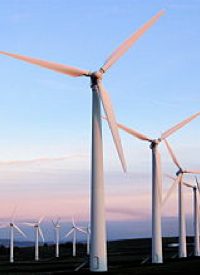
One dilemma faced by environmentalists pushing the use of wind farms to generate electricity is that the machines are actually a deadly environmental hazard — to birds. For instance, the huge turbines of the Los Angeles Department of Water and Power’s wind farm in the Tehachapi Mountains north of Los Angeles have recently killed two more golden eagles — bringing the total of these endangered birds killed by the turbines’ blades at the Pine Tree facility to eight.
According to the Los Angeles Times:
The death rate per turbine at the $425-million [Pine Tree] facility is three times higher than at California’s Altamost Pass Wind Resource Area [near Livermore], where about 57 golden eagles die each year. However, the Altamont Pass facility has 5,000 wind turbines — 55 times as many as Pine Tree.
Wind turbine blades may spin up to 200 miles per hour, making it difficult for these flying predators to avoid them as they concentrate on scanning the ground for prey. According to Los Angeles Department of Water and Power spokesman Brooks Baker, the department is attempting to develop a bird and bat protection plan. Biologist Ileene Anderson of the Center for Biological Diversity claims that the real problem is the location of the wind turbines, and the appropriate response is to redesign the wind farm and put a moratorium on any new construction until the problem is corrected. Audubon California’s Garry George maintains that before any new wind farms are built, years of research should be devoted to the behavior of birds which might fly near the turbines.
The killing of these federally-protected birds may actually be a federal offense, although so far no wind farm operators have been prosecuted. The threat of prosecution, however, may affect future development of these farms. A coalition of environmental groups has sued Kern County, California, to stop construction of wind farms near North Sky River and Jawbone, alleging that the turbines would create an unacceptable risk for golden eagles, as well as for California condors, also an endangered species.
The Pine Tree wind farm golden eagle killings is simply the latest of many problems which wind turbines pose to endangered species. Last year Canada’s Gilead Power wind farm projects in Ontario ran into environmentalist opposition because of their harmful effects on whippoorwills and Blanding’s turtles, both listed by our northern neighbor as endangered species. The South Shore Conservancy environmentalist group made note of “Gilead Power’s application for a permit to kill, harm and harass species at risk at Ostrander Point.”
Efforts to mitigate the effect of wind turbines on birds seem likely to raise the cost of wind-generated electricity even higher. The Peñascal Wind Power Project in Texas, built with $222 million of stimulus funds, has avian radar which causes the turbines to shut down if birds are detected as far as four miles away. Of course the loss of electrical power will either require the generation of power by fossil fuel plants — something that environmentalists strongly oppose — or customers will simply have to do without power.
But a growing number of people are realizing that wind power is not even a sensible form of electricity generation in the first place. As The New American‘s Alex Newman pointed out so well in an article on the subject last year,
Across the country, subsidized wind farms are meeting increasing resistance — and not just from taxpayers and electricity consumers forced to foot the bill. “If wind power made sense, why would it need a government subsidy in the first place?” wondered Heritage Foundation policy analyst Ben Lieberman, who deals with energy and environmental issues. “It’s a bubble which bursts as soon as the government subsidies end.”
It turns out that wind power is expensive and inefficient even in the best wind-farm locations in the world. And regular power plants always need to be on standby in case there is no wind, not enough wind, or even too much of it — a fairly regular occurrence.
That is why, when the tax subsidies run out, the towering metallic structures are often simply abandoned. In their wake: a scarred landscape and dead wildlife — the very same ills offered as justifications by administration officials for preventing oil exploration.



